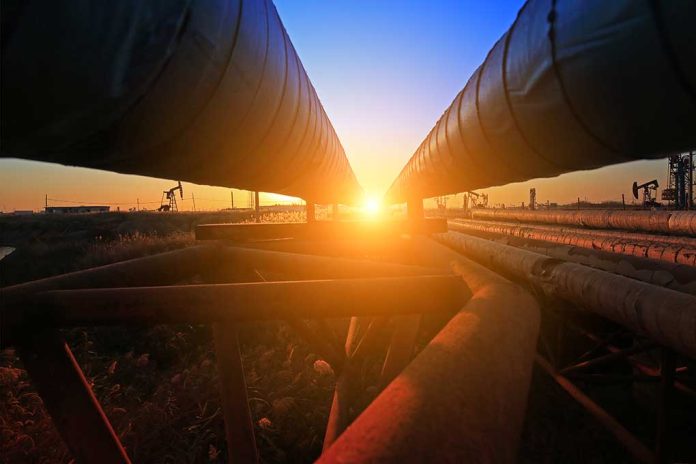
The Keystone pipeline, a crucial artery for Canadian crude oil delivery to the United States, has been shut down after a mysterious “bang” was heard at a pump station in North Dakota, raising new concerns about the controversial energy infrastructure.
Key Takeaways
- A sudden rupture in the Keystone pipeline in North Dakota led to an immediate shutdown after an employee heard a mechanical “bang” and the control center detected a pressure drop.
- Crude oil was released into an agricultural field near Fort Ransom, but the spill was quickly contained with no impact to nearby waterways or structures.
- The pipeline, operational since 2010, normally transports 624,000 barrels of Canadian crude oil daily to U.S. refineries.
- This incident adds to the pipeline’s troubled history, which includes at least three significant spills since 2017, fueling debate about pipeline safety.
- The controversial Keystone XL extension, which would have created thousands of jobs and billions in economic impact, was canceled by President Biden in 2021 despite support from Canadian officials and many Americans.
Swift Response Prevents Major Environmental Damage
The Keystone Pipeline was shut down after a rupture occurred in North Dakota. According to Bill Suess, spill investigation program manager with the North Dakota Department of Environmental Quality, the incident triggered an immediate response. “The Keystone Pipeline was shut down after a ‘bang’ was reported in North Dakota,” Suess confirmed. The rupture happened near Fort Ransom at milepost 171, where an alert employee took decisive action after hearing what was described as a mechanical noise.
South Bow, the company that has managed the pipeline since early 2024, detected a sudden pressure drop in their control center and immediately initiated shutdown protocols. The quick response appears to have limited the environmental impact, as crude oil was released into an agricultural field south of the pump station but did not reach any water sources. The North Dakota Department of Environmental Quality is now overseeing remediation efforts at the site, with officials confirming that no people or structures were affected by the spill.
BREAKING NEWS:
The Keystone Pipeline has RUPTURED.
Oil spill near Edinburgh, North Dakota after rupture of Keystone pipeline. pic.twitter.com/ScJbcKc98b
— Mila Joy (@MilaLovesJoe) April 9, 2025
Pipeline’s Troubled History Continues
This rupture adds to a growing list of incidents for the Keystone pipeline system, which has experienced at least three significant spills since 2017. The most severe occurred in 2022 in Kansas, raising questions about the infrastructure’s reliability. South Bow has released limited information about the current spill, stating they have made “appropriate notifications to our regulators, landowners and customers.” The investigation into the cause of the rupture and the exact amount of oil spilled remains ongoing.
The Keystone pipeline, completed in 2010 at a cost of $5.2 billion, normally transports an average of 624,000 barrels of oil per day from oil sand fields in Alberta, Canada to refineries in Illinois and Oklahoma. Authorities expect this most recent spill to be smaller than previous incidents, such as a past spill in Walsh County, North Dakota, though exact assessments are still underway. The pipeline remains a critical piece of North American energy infrastructure despite its operational challenges.
Economic Impact and Lost Opportunities
The Keystone pipeline system has been a lightning rod for political debate, particularly regarding its proposed Keystone XL expansion project. This extension would have increased capacity to 830,000 barrels of crude oil per day and created substantial economic benefits. A 2014 analysis projected the XL expansion would support approximately 42,100 jobs and contribute $3.4 billion to the U.S. GDP. Additionally, the project was expected to generate $55.6 million in annual property tax revenue across Montana, South Dakota, and Nebraska.
The cancellation of the Keystone XL extension by President Joe Biden in 2021 drew sharp criticism from Canadian officials and President Donald Trump, who has consistently called for its completion. Many energy sector experts and local communities along the proposed route had anticipated economic benefits from the project. This latest incident will likely reignite discussions about American energy independence and the safest methods for transporting essential petroleum products across North America, especially as global energy markets face ongoing instability.
Sources:
Keystone oil pipeline shut down after “mechanical bang” reported
Keystone pipeline shut down after rupture
Keystone pipeline shut down after rupture, oil spill contained













